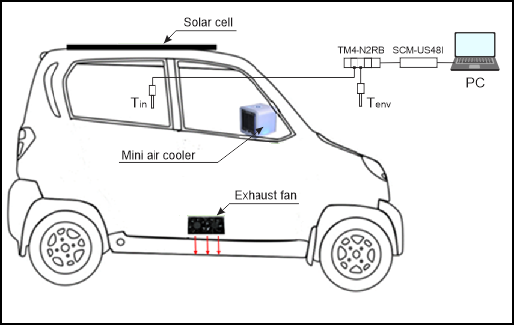Main Article Content
Abstract
Deaths among children and pets, as well as damage to car interior components, have been widely reported as a result of parking under direct sunlight for a long time. Rising car cabin temperatures in this condition trigger the formation of benzene gas, but it is not possible to turn on the AC due to security and energy consumption. Therefore, this article reports the experimental study on cabin cooling system for parked car under direct sunlight by applying a mini air cooler and exhaust fan powered by a solar cell on small car Bajaj Qute RE60. Two thermocouples were installed inside and outside the cabin to monitor the temperature for 7 hours, expressing daytime heat conditions. The results showed that this cooling system could reduce the temperature to 10 K by removing 8982 kJ (0.356 kW) of heat. In conclusion, this prototype is very promising to be developed and if implemented on a larger scale will reduce car interior damage while parking under direct sunlight.
Keywords
Article Details

This work is licensed under a Creative Commons Attribution-NonCommercial 4.0 International License.
References
- Y. Mao, J. Wang, and J. Li, “Experimental and numerical study of air flow and temperature variations in an electric vehicle cabin during cooling and heating,” Applied Thermal Engineering, vol. 137, no. March, pp. 356–367, 2018.
- A. Mezrhab and M. Bouzidi, “Computation of thermal comfort inside a passenger car compartment,” Applied Thermal Engineering, vol. 26, no. 14, pp. 1697–1704, 2006.
- R. Saidur, H. H. Masjuki, and M. Hasanuzzaman, “Performance Of An Improved Solar Car Ventilator,” International Journal of Mechanical and Materials Engineering, vol. 4, no. 1, pp. 24–34, 2009.
- A. Grundstein, V. Meentemeyer, and J. Dowd, “Maximum vehicle cabin temperatures under different meteorological conditions,” International Journal of Biometeorology, vol. 53, no. 3, pp. 255–261, 2009.
- M. A. Jasni and F. M. Nasir, “Experimental Comparison Study of the Passive Methods in Reducing Car Cabin Interior Temperature,” In International Conference on Mechanical, Automobile and Robotics Engineering (ICMAR'2012), Penang. 2012, pp. 229–233.
- H. Tsutsumi, Y. Hoda, S. Tanabe, and A, Arishiro, “Effect of Car Cabin Environment on Driver’s Comfort and Fatigue,” SAE Technical Papers, no. 2007-01-0444, 2007.
- P. Taylor, M. F. Allnutt, and J. R. Allan, “The Effects of Core Temperature Elevation and Thermal Sensation on Performance,” Ergonomics, no. October 2014, pp. 37–41, 2007.
- C. Qi, Y. Helian, J. Liu, and L. Zhang, “Experiment Study on the Thermal Comfort inside a Car Passenger Compartment,” Procedia Engineering, vol. 205, pp. 3607–3614, 2017.
- I. Aljubury, A. Farhan, and M. Mussa, “Experimental Study of Interior Temperature Distribution Inside Parked Automobile Cabin”, Journal of Engineering, vol. 21, no. 3, pp. 1-10, Mar. 2015.
- W. A. Abd-Fadeel and S. A. Hassanein, “Temperature variations in a parked car exposed to direct sun during hot and dry climates,” International Journal of Automobile Engineering Research & Development, vol. 3, no. 1, pp. 75–80, 2013.
- K. Omar, “Detection of the vapor benzene composition formed inside the car cabin,” Chemical Physics, vol. 36, no. 2011, pp. 3501–3503, 2011.
- D. Costa and A. Grundstein, “An analysis of children left unattended in parked motor vehicles in Brazil,” International Journal of Environmental Research and Public Health, vol. 13, no. 7, 2016.
- P. Ferrara et al., “Children left unattended in parked vehicles: A focus on recent italian cases and a review of literature,” Italian Journal of Pediatrics, vol. 39, no. 1, p. 1, 2013.
- M. F. Basar, M. Musa, M. Y. Faizal, and N. H. a Razik, “Alternative Way in Reducing Car Cabin Temperature Using Portable Car Cooling System (Car-Cool),” International Journal of Innovative Technology and Exploring Engineering, vol. 3, no. 3, pp. 140–143, 2013.
- A. A. Lahimer, M. A. Alghoul, K. Sopian, and N. G. Khrit, “Potential of solar reflective cover on regulating the car cabin conditions and fuel consumption,” Applied Thermal Engineering, vol. 143, no. April, pp. 59–71, 2018.
- M. Kolhe, S. K. Adhikari, and T. Muneer, “Parked electric car’s cabin heat management using photovoltaic powered ventilation system,” Applied Energy, vol. 233–234, no. January 2018, pp. 403–411, 2019.
- C. V Sudhir, J. Marhoon, and A. Dhali, “Effect of solar ventilation on air conditioning system performance of the car parked under sun light,” ARPN Journal of Engineering and Applied Sciences, vol. 10, no. 22, pp. 10618–10626, 2015.
- M. Setiyo, S. Soeparman, S. Wahyudi, and N. Hamidi, “The Alternative Way to Drive the Automobile Air-Conditioning, Improve Performance, and Mitigate the High Temperature: A Literature Overview,” Periodica Polytechnica Transportation Engineering, vol. 46, no. 1, pp. 36–41, Aug. 2018.
- M. Setiyo, B. Waluyo, N. Widodo, M. L. Rochman, and I. B. Raharja, “Performance of mini air cooler on parked car under direct sunlight,” in Journal of Physics: Conference Series, 2020, vol. 1517, p. 12002.
- S. C. Vishweshwara, J. Marhoon, and A. L. Dhali, “Study of Excessive Cabin Temperatures of the Car Parked in Oman and its Mitigation,” International Journal Of Multidisciplinary Sciences And Engineering, vol. 4, no. 9, pp. 18–22, 2013.

